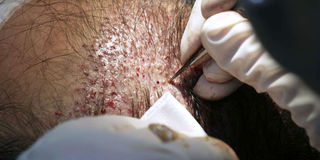Are you losing hair? Here's why

One option for people with hair loss to to get a hair transplant.
Alopecia (hair loss) is a common condition that many women have suffered from at some point in their lives, but with successful restoration of normal hair. Men, on the other hand, experience normal male pattern baldness that comes with age, commonly referred to as androgenic alopecia.
Many women have had an episode or two of hair loss in search of beauty. We have sat through harrowing experiences at the salon, silently gnashing our teeth as our rebelliously kinky African hair was pulled back in tight braids or cornrows to ensure it was tame enough to look presentable. After all the torture, a few weeks later, the braids came out and so did our hairline, much to our chagrin. This is when we come face to face with the ugly reality of traction alopecia and wonder why we just did not let the wild hair be. Uncombed hair never killed anyone!
As if the salon horrors are not enough, pregnancy and childbirth comes with its own hair loss nightmares. Most mums incorrectly believe that breastfeeding makes their hair fall off. However, during pregnancy, the hormones foster rapid hair growth that makes the hair appear more voluminous. This growth is driven by high oestrogen levels. After delivery, the oestrogen levels fall rapidly, leading to the hair going into resting phase and shedding off. It will generally settle in about six months.
Children do get affected by hair loss too. Malnutrition is the first culprit on the list. The hair gets really fine and brown and easily falls out. This is a direct result of inadequate vitamins and minerals that accompanies the overall inadequacy of nutrients in the developing body. However, it is worth noting that other chronic illnesses can also mess with hair growth cycle and lead to hair thinning.
Medications are also implicated in hair loss. The hallmark of chemotherapy for cancer is complete or almost complete hair loss. Every time the hair starts to grow, the next round of chemotherapy wipes it all out. Spotting a bald look has become acceptable for most patients. It helps to be sensitive to patients with hair loss because you may be talking to someone who has bigger demons to slay.
AUTOIMMUNE DISEASE
While for most people, hair loss is a temporary affair that will resolve, this may not be the case for my friend who suffers from alopecia areata. For many years, she struggled with accepting it. She blamed it on stress and tension braiding. What she had not figured out was that her hair loss is a medical condition caused by a misbehaving immune system. Alopecia areata is an autoimmune condition where the body’s immune system attacks the hair follicles, destroying them and rendering them incapable of supporting hair growth. This results in hair falling off and being unable to grow back. On average, every normal individual loses 75 to 100 hairs a day. These grow back continuously hence we do not notice the loss. For my friend, much more hair is lost and re-growth is non-existent.
This may happen in patches that recover with time or in severe conditions, the patches may overlap, leading to large patches of hair loss. In extreme cases the hair loss is all over the body, with loss of eyebrows, lashes, axillary and pubic hair, a rare occurrence termed alopecia universalis.
It is not uncommon to find that patients with alopecia areata have other autoimmune diseases such as lupus, eczema or atopic rhinitis. It therefore manifests itself as part of a spectrum of conditions that can cause extreme discomfort and potentially life-threatening conditions. By itself however, it does not cause any morbid complications.
While hair loss is an extremely distressing condition that leads to loss of self-esteem, several treatment modalities have been employed to restore some semblance of normalcy. Use of steroid-based creams and minoxidil (a drug that was initially used to treat high blood pressure until it was found to cause excessive hair growth and converted for this use) has yielded positive results.
EXPERIMENTAL TREATMENT
For some patients, recovery is 100 per cent. Others may experience relapses throughout their lives. Some may fail to respond completely, leading to continued research on treatment options that may work. Some of the experimental treatments include vitamin D supplementation and platelet-rich plasma (PRP) injections. Locally, we have had a surge in the number of trichology centres that have attempted to provide solutions for hair loss. PRP injections are now routinely administered alongside hair transplants to ensure the transplanted follicles survive the attack by the immune system. Just ensure the clinic you visit is run by registered doctors: either dermatologists, a plastic surgeon or general surgeons who are appropriately trained to understand the physiology of the skin and hair. Before you say something hurtful to women in expensive wigs, remember that it may be a sign of bigger medical struggles.



